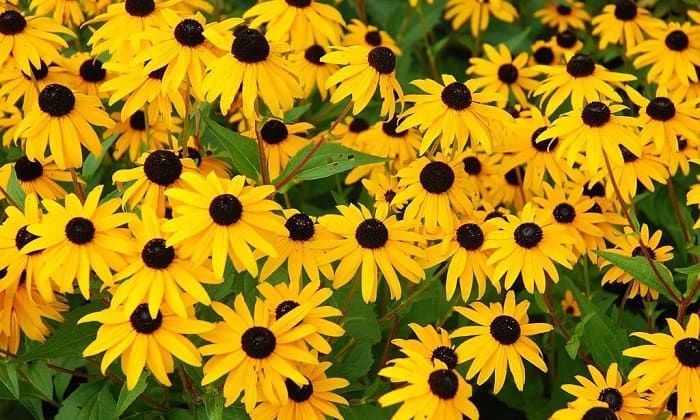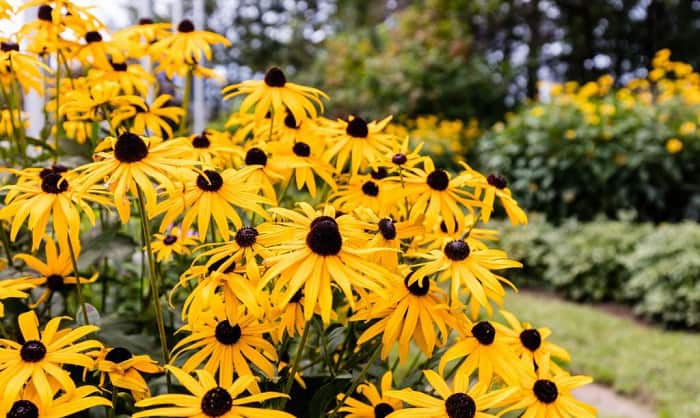Black-eyed Susans are known for their vibrant look and ability to complement many plants, such as coneflower, zinnia, and yarrow. Growing these yellow flowers is a wise choice if you want to brighten up your yard.
So when to plant black-eyed Susan seeds? The black eyed Susan season can be either spring or fall. Read below and learn how to cultivate this flower.
Table of Contents
Best Time to Plant Black-eyed Susan Seeds
1. In fall
Black-eyed Susans need a period of cold treatment to sprout, and for autumn planting, this treatment can be provided in the form of winter sowing.
In detail, it is best to grow black eyed Susans six weeks before the first frost. When you do this, they will overwinter and then bloom in spring. In fact, these flower seeds need to experience at least three months of sub-40-degrees temperatures from the moment they’re planted.
Hence, you should look up your first frost and sow them outdoors following the timing recommendation above. Typically, it should be around mid-fall.
Here are some quick tips on how to winter sow black-eyed Susans:
- Find a clean milk jug and create five to eight drain holes on its bottom (each hole should be ⅛ inch in diameter).
- Then, cut the jug in half. The bottom half of the jug will be where you put your potting soil. Make sure to leave ½ inch of space from the top of the soil to the upper side of the container, and mist the soil so it’s moist.
- Sow the seeds and tape the two halves of the jug together.
- Put the jug outside where the sun can’t reach (you don’t need to close its lid) and water the soil if it gets dry.
- When spring comes, the seeds will germinate.
2. In spring
Another time for planting black eyed Susans is spring. Similar to fall planting, you need to put the seeds through a period of cold treatment or stratification – in other words – refrigerate them.
In practice, the requirement for this task is somewhat similar to winter sowing.
You should find a bag, fill it with wet sand and black-eyed Susan seeds, then refrigerate the whole thing for three months at 40℉ or lower. Note that for indoor planting, it’s possible to put the seeds in pots first before bagging them.
Then, remove the seeds from the fridge four to six weeks before the last frost to plant them indoors.
Alternatively, keep them in cold storage until frost has passed before sowing the seeds outdoors directly.
Either way, the transplant and outdoor sowing time are the same (after the last frost).
Tips for Planting Black-eyed Susan Seeds
1. How to choose black-eyed Susan seeds
- When choosing black-eyed Susan seeds, you may come across black-eyed Susan vine seeds.
- Though the two sound similar, the latter is from a different plant family (acanthus instead of daisy), so it’s best not to confuse Susan vines with the black-eyed Susans you want to grow.
- To avoid mistaking one for the other, you can remember their scientific names. Black-eyed Susans are Rudbeckia (including Rudbeckia hirta, fulgida, laciniata, and subtomentosa), while Susan vines are Thunbergia alata.
- It’s also best to pick black-eyed Susans according to your hardiness
- For example, the Indian Summer variety grows best in zone 3 to zone 7, while the Cherokee Sunset is ideal for zone 5 to 9. If you live in Ohio, which has zone 5 and 6, you can grow both of them.
2. Where to plant black-eyed Susans
- Black-eyed Susans grow best in zone 3 to 9. Colder and hotter zones outside this range are not ideal for them, so you should look up your hardiness region before planting.
- Aside from the climate, it is best to keep in mind the following criteria when selecting your planting location:
- Black-eyed Susans should get at least six hours of sunlight per day. That said, some varieties, such as the subtomentosa, will grow in either full sun or shade (as long as the shade is only partial).
- Ensure the garden bed or pot measures 70 to 75℉ and that there are 12 to 18 inches of space between two plants.
- It’s also wise to test the soil and ensure it has a pH of 6.8 to 7.7. It should also drain well as black-eyed Susans plants don’t really tolerate soggy soil.
3. How to plant black-eyed Susans
Plant black-eyed Susan seeds indoors in spring
- Follow our tips above on refrigerating the seeds. Note that you’ll need to begin stratification five months before the last frost. Aside from using sand for bagging, you can use sphagnum moss.
- As the seeds undergo their cold treatment and the final frost approaches, prepare pots for planting. Fill them with perlite, medium-grit sand, and potting soil in a ratio of 1:1:4.
- Then, as mentioned above, remove the seeds from the fridge four to six weeks before the final spring frost (though you can go for eight weeks if you want).
- Put two seeds in one pot, and don’t cover them with too much soil. But how deep should you ‘bury’ the seeds, really? There actually should be no planting depth. Just dust the seeds lightly with soil so that sunlight can reach them.
- Afterward, mist the top of the pots and put them somewhere with the right heat and sunlight levels (see our tips above).
- As you wait for germination, keep the soil moist using a spray bottle rather than a watering can. Additionally, find plastic wrap to cover the top of the pot (but not its outer edges) to help retain moisture.
- Once germination occurs, you can remove this plastic layer. Make sure to satisfy the plant’s water requirements still (specifically, the top 0.5 inch of the soil should be wet).
- Finally, move the black-eyed Susans outside once frost has passed.
Plant black-eyed Susan in fall/winter
First, set up your milk jug just like we described above. Once spring comes, you can move the jugs to a sunny location. Then, as the weather warms up and the seeds germinate, dig up the seedlings and put them into the garden bed.
Alternatively, you can skip the milk jug and just sow seeds directly into the garden bed. Follow the seeding rate of six seeds for every square foot, and apply 2 inches of compost onto the soil.
Frequently Asked Questions
Should I soak black-eyed Susan seeds before planting?
No, you should not soak them. These seeds need moist soil, yes, but soaking them is unnecessary.
On the other hand, if you grow Susan vine plants, soaking the seeds before planting will accelerate sprouting.
Does black-eyed Susan plant come back every year? When will they come up?
Whether a black-eyed Susan plant comes back annually depends on its variety. If you grow perennial seeds like the Gloriosa Daisies, then yes, expect them to flower yearly. An annual, however, will only bloom once.
As for when they come up, it takes around a week for black-eyed Susans to sprout (not including the stratification time), and flowers tend to appear in June to September.
Will black-eyed Susans bloom the first year from seed?
Black-eyed Susans often don’t bloom until the second year of planting, since many places such as Vermont sow them as biennials.
However, if the growing season is long enough and you plant Rudbeckia at the right time (e.g., seeding happens indoors at least 6 weeks before the last frost), you won’t have to wait two years for flowers.
In Florida and Georgia, for instance, Rudbeckia hirta may bloom right within the first year.
How to plant black-eyed Susan roots
- First, soak the roots in a water container for an hour.
- Then, get a pot, fill it with compost and sand, and mix the two components together.
- Create a hole in the compost mixture for the root to sit in. Make sure to leave the root’s crown exposed above the soil.
- Finally, water the pot and wait for sprouting to occur.
Conclusion
Hopefully, you now know when to plant black-eyed Susan seeds.
They produce gorgeous flowers, and it’s not tough to grow them either since they don’t have that many pests or diseases.
What’s more, if you live in a northern state, these plants can be wonderful additions to your garden. Unlike other flowers, you won’t need to worry about winter temperatures killing Rudbeckia.
Have you sowed black-eyed Susans before? If you haven’t, how about growing them next spring?

Hi, I am William – Floridayards’ digital content creator. My job is to find answers to all your concerns with thorough research and our team’s expert advice. I will also bring you honest reviews on the best products and equipment for raising your beautiful garden. Please look forward to our work!













